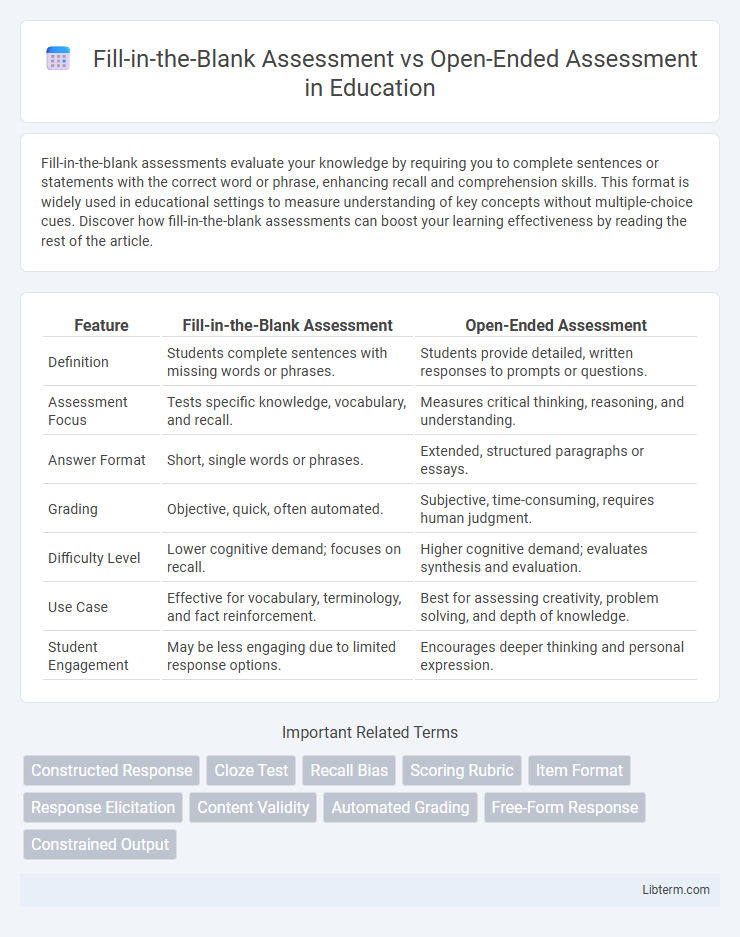Fill-in-the-blank assessments evaluate your knowledge by requiring you to complete sentences or statements with the correct word or phrase, enhancing recall and comprehension skills. This format is widely used in educational settings to measure understanding of key concepts without multiple-choice cues. Discover how fill-in-the-blank assessments can boost your learning effectiveness by reading the rest of the article.
Table of Comparison
| Feature | Fill-in-the-Blank Assessment | Open-Ended Assessment |
|---|---|---|
| Definition | Students complete sentences with missing words or phrases. | Students provide detailed, written responses to prompts or questions. |
| Assessment Focus | Tests specific knowledge, vocabulary, and recall. | Measures critical thinking, reasoning, and understanding. |
| Answer Format | Short, single words or phrases. | Extended, structured paragraphs or essays. |
| Grading | Objective, quick, often automated. | Subjective, time-consuming, requires human judgment. |
| Difficulty Level | Lower cognitive demand; focuses on recall. | Higher cognitive demand; evaluates synthesis and evaluation. |
| Use Case | Effective for vocabulary, terminology, and fact reinforcement. | Best for assessing creativity, problem solving, and depth of knowledge. |
| Student Engagement | May be less engaging due to limited response options. | Encourages deeper thinking and personal expression. |
Introduction to Assessment Types
Fill-in-the-Blank assessments require learners to complete sentences or statements by providing specific missing words or phrases, which allows for targeted evaluation of knowledge recall and precision. Open-Ended assessments prompt learners to produce detailed responses, fostering critical thinking and comprehensive expression of understanding across a subject. Both assessment types play crucial roles in measuring different cognitive skills within educational frameworks and standardized testing environments.
Defining Fill-in-the-Blank Assessments
Fill-in-the-blank assessments require students to complete sentences by inserting specific words or phrases, which tests precise knowledge recall and vocabulary skills. These assessments are highly effective for evaluating factual understanding and discrete information such as terminology, dates, or formulas. Unlike open-ended assessments that demand elaborate responses, fill-in-the-blank tasks offer measurable, concise data points ideal for objective grading and quick feedback.
Understanding Open-Ended Assessments
Open-ended assessments provide a comprehensive measure of critical thinking, creativity, and problem-solving skills by requiring students to construct their own responses rather than selecting from predefined options. Unlike fill-in-the-blank assessments that mainly test recall and recognition, open-ended formats evaluate deeper comprehension and the ability to articulate complex ideas clearly and effectively. Educators value open-ended assessments for their capacity to reveal nuanced understanding and promote higher-order cognitive skills essential for academic and real-world success.
Key Differences Between the Two Approaches
Fill-in-the-blank assessments require students to provide specific answers, promoting recall and precision, while open-ended assessments encourage critical thinking and elaboration through free-form responses. Fill-in-the-blank tests are easily graded for accuracy and efficiency, making them suitable for large-scale testing, whereas open-ended assessments demand subjective grading that assesses depth of understanding and creativity. The key difference lies in the balance between objective measurement of specific knowledge and the evaluation of higher-order cognitive skills.
Advantages of Fill-in-the-Blank Assessments
Fill-in-the-blank assessments offer precise measurement of students' knowledge by requiring exact recall of information, reducing guesswork inherent in multiple-choice formats. These assessments enable efficient grading through automated systems, saving time while maintaining accuracy. They also promote active engagement and reinforce memory retention by prompting learners to produce specific responses rather than selecting from given options.
Benefits of Open-Ended Assessments
Open-ended assessments foster critical thinking and creativity by requiring students to generate original responses and demonstrate deeper understanding beyond memorization. These assessments provide educators with richer insights into students' reasoning processes and conceptual grasp, enabling targeted feedback and personalized instruction. Unlike fill-in-the-blank tests, open-ended formats accommodate diverse thought processes and enhance higher-order cognitive skills essential for academic and real-world problem-solving.
Challenges and Limitations of Each Method
Fill-in-the-blank assessments face challenges related to limited response variability and the potential for guessing, making it difficult to evaluate higher-order thinking skills accurately. Open-ended assessments struggle with subjective grading and time-intensive evaluation processes, which can reduce consistency and scalability in large classrooms. Both methods also encounter limitations in capturing the full depth of student understanding, with fill-in-the-blank favoring recall and open-ended requiring extensive interpretation.
Situational Applications of Both Assessments
Fill-in-the-blank assessments excel in scenarios requiring quick recall of specific facts or vocabulary, making them ideal for language learning or basic knowledge checks. Open-ended assessments are better suited for evaluating critical thinking, reasoning, and the ability to articulate complex ideas, commonly used in humanities and problem-solving tasks. Both assessment types complement each other by addressing different cognitive skills and providing a more comprehensive evaluation when applied appropriately.
Impact on Student Learning and Performance
Fill-in-the-blank assessments enhance student recall and reinforce specific knowledge by requiring precise answers, which can improve retention and accuracy. Open-ended assessments promote critical thinking, creativity, and deeper understanding by encouraging students to explain concepts in their own words. Combining both methods can provide a balanced evaluation, supporting diverse learning styles and fostering comprehensive student performance.
Choosing the Right Assessment for Your Needs
Fill-in-the-blank assessments offer efficient evaluation of specific knowledge with objective scoring, ideal for testing factual recall and vocabulary. Open-ended assessments provide insights into critical thinking and problem-solving skills, allowing deeper analysis of student understanding through flexible responses. Selecting the right assessment depends on learning objectives, with fill-in-the-blank suited for targeted knowledge checks, while open-ended formats support comprehensive skill evaluation.
Fill-in-the-Blank Assessment Infographic

 libterm.com
libterm.com